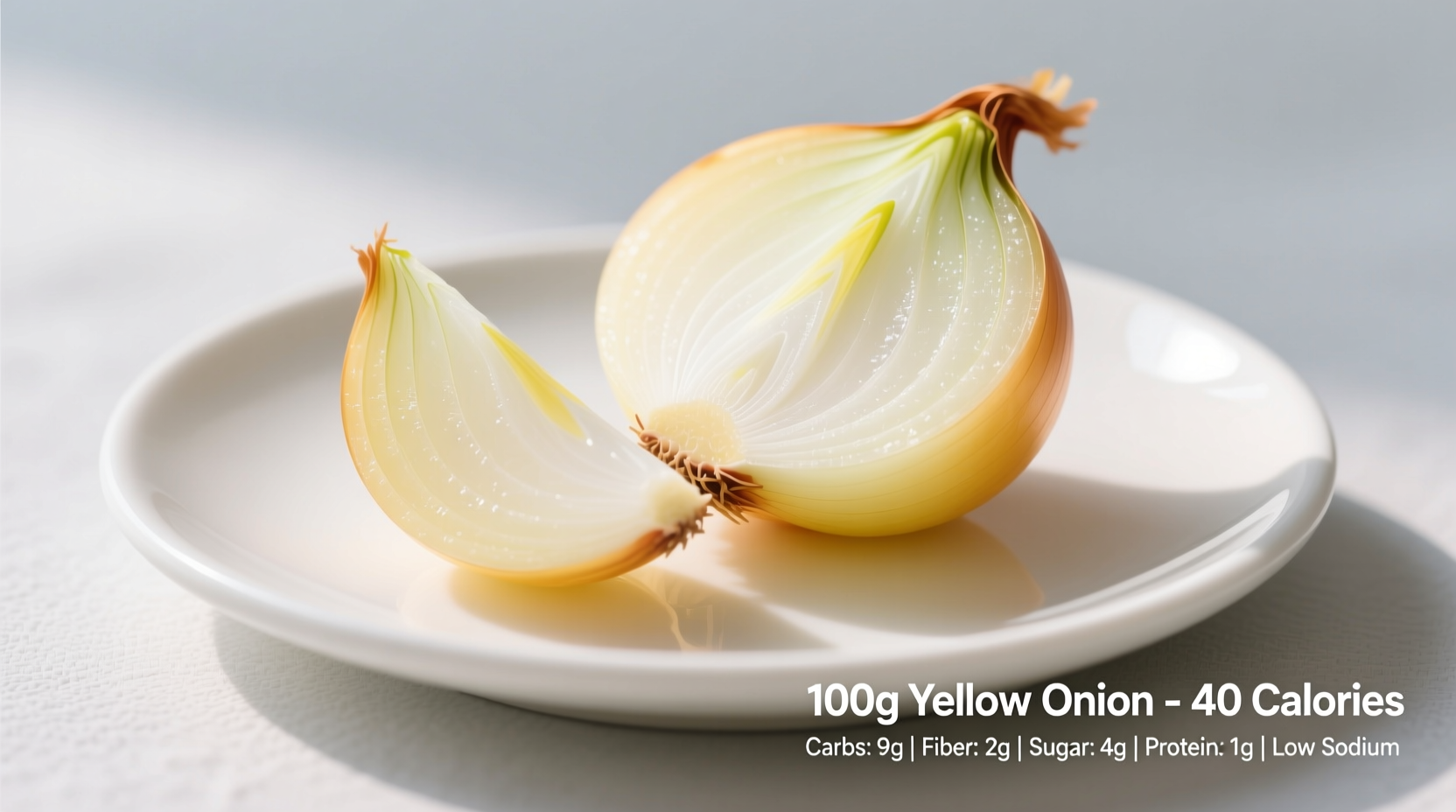When tracking your daily nutrition, knowing the precise calorie count of common ingredients like yellow onions is essential for accurate meal planning. Whether you're managing dietary goals, counting macros, or simply curious about this kitchen staple, understanding the nutritional facts helps you make informed cooking decisions.
Nutritional Breakdown of Yellow Onions
According to the USDA FoodData Central database, yellow onions offer a remarkably low-calorie profile while delivering valuable nutrients. The exact count depends on serving size, but here's what the numbers reveal:
| Serving Size | Calories | Carbohydrates (g) | Fiber (g) | Sugar (g) |
|---|---|---|---|---|
| 100g raw yellow onion | 40 | 9.3 | 1.7 | 4.2 |
| Medium onion (110g) | 44 | 10.2 | 1.9 | 4.6 |
| 1/4 cup chopped (40g) | 16 | 3.7 | 0.7 | 1.7 |
| 1 cup chopped (160g) | 64 | 14.9 | 2.7 | 6.8 |
This nutritional profile comes from the USDA's most recent analysis of raw yellow onions (Allium cepa), the most commonly used variety in American kitchens. The data reflects onions in their raw state, as cooking methods can slightly alter nutritional values through water loss or caramelization processes.
How Yellow Onions Compare to Other Varieties
Not all onions are nutritionally identical. While calorie counts remain relatively consistent across varieties, subtle differences exist in sugar content and nutrient density:
- Yellow onions: 40 calories per 100g, higher sulfur compounds (more pungent, better for cooking)
- Red onions: 40 calories per 100g, contain anthocyanins (antioxidants giving purple color)
- White onions: 42 calories per 100g, milder flavor, slightly higher water content
- Shallots: 72 calories per 100g, more concentrated flavor and nutrients
- Green onions: 32 calories per 100g, lower carbohydrate content
These comparisons come from side-by-side analysis in the USDA FoodData Central, which maintains standardized testing protocols for consistent nutritional reporting across produce varieties.
Practical Calorie Management in Cooking
Understanding how yellow onions contribute to your meal's total calorie count helps with precise dietary planning. Consider these real-world applications:
When sautéing onions for a recipe serving four people, using one medium yellow onion (44 calories total) adds just 11 calories per serving. This makes them an excellent flavor foundation without significant caloric impact. For those following specific dietary patterns:
- Keto diets: Yellow onions contain 9g net carbs per 100g, so moderate portions fit within daily limits
- Diabetes management: The 1.7g fiber per 100g helps moderate blood sugar response to carbohydrates
- Weight loss: Their strong flavor allows using smaller quantities while still enhancing dishes
Professional chefs often recommend reserving sweeter varieties like Vidalia for raw applications while using yellow onions for cooking, as their higher sulfur content creates richer flavor compounds when heated without adding significant calories.

Beyond Calories: Nutritional Benefits of Yellow Onions
While the calorie count matters for dietary tracking, yellow onions offer valuable nutritional components beyond their energy content:
- Vitamin C: 7.4mg per 100g (8% of daily value) - supports immune function
- Vitamin B6: 0.12mg per 100g (7% of daily value) - aids metabolism
- Manganese: 0.13mg per 100g (6% of daily value) - important for bone health
- Quercetin: A flavonoid antioxidant with anti-inflammatory properties
- Organosulfur compounds: May support cardiovascular health
Research published in the Journal of Nutrition and Metabolism indicates that regular onion consumption correlates with improved cardiovascular markers, demonstrating that the nutritional value extends far beyond the modest calorie count.
Maximizing Nutritional Value in Preparation
How you prepare yellow onions affects their nutritional profile. To preserve maximum nutrients while managing calories:
- Store whole onions in a cool, dry place (not the refrigerator) to maintain nutrient density
- Leave the outer layers intact until ready to use - they contain concentrated antioxidants
- Chop and wait 10 minutes before cooking to activate beneficial enzymes
- Avoid overcooking, which can degrade heat-sensitive vitamins
- Use minimal oil when sautéing to prevent unnecessary calorie addition
These preparation techniques help maintain the natural nutritional benefits while keeping the calorie count predictable for dietary tracking purposes.
Common Questions About Onion Nutrition
Many home cooks have specific questions about incorporating yellow onions into their nutrition plans. Here are answers to the most frequent inquiries:











 浙公网安备
33010002000092号
浙公网安备
33010002000092号 浙B2-20120091-4
浙B2-20120091-4